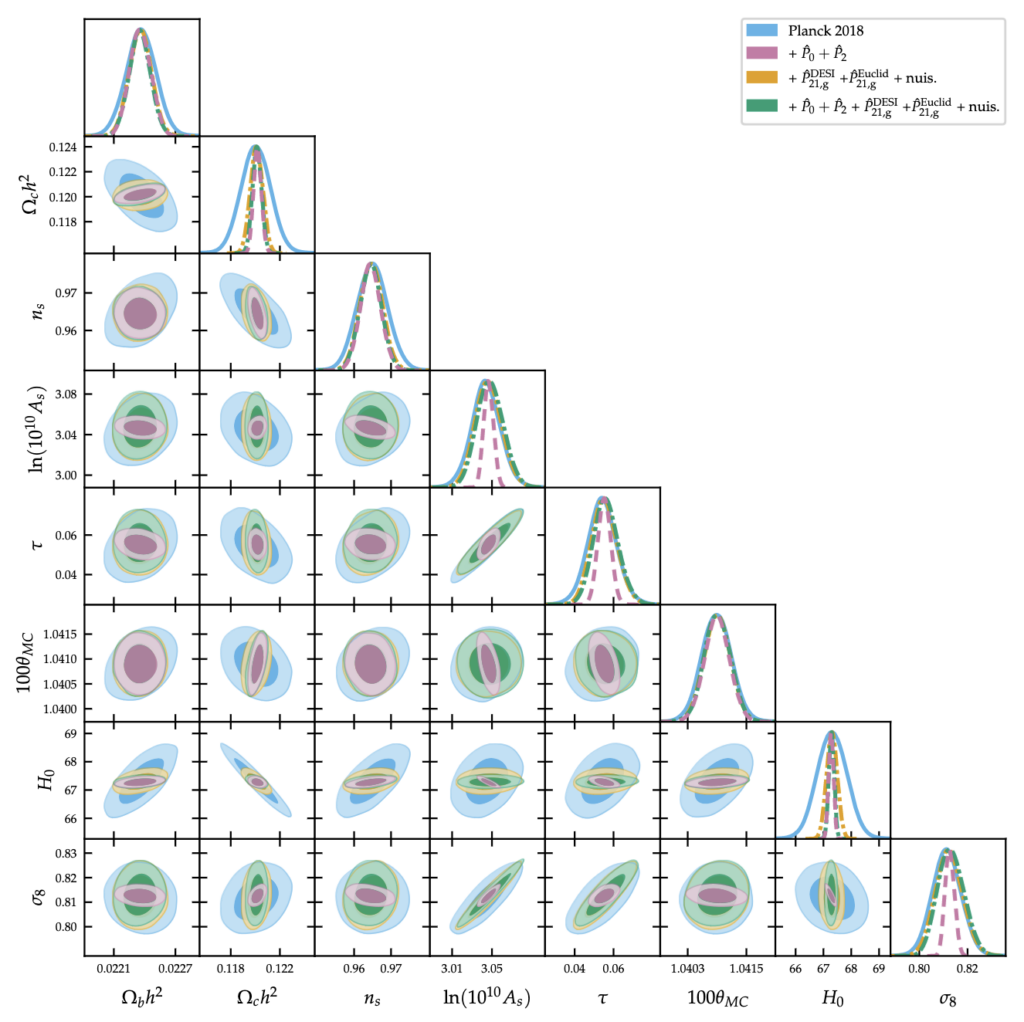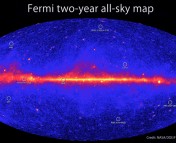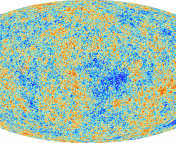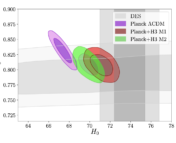Authors: Maria Berti, Marta Spinelli, Matteo Viel
First Author’s Institutions: Trieste, Italy; International School for Advanced Studies, National Institute for Nuclear Physics, Institute for Fundamental Physics of the Universe
Status: Submitted to MNRAS [closed access]
The so-called ΛCDM model of cosmology is the standard framework for how cosmologists think about the structure, content, and history of the Universe, from its very first moments during the era of inflation to the modern epoch. It describes the entirety of spacetime in just six parameters, and the more precisely we understand those parameters, the better equipped we are to answer fundamental questions in cosmology–including the infamous Hubble tension. The authors of today’s paper describe and test a new method for estimating these parameters using a 3D map of the Universe’s large-scale structure.
The seeds of large-scale structure
Traditionally, ΛCDM parameters are estimated using the Cosmic Microwave Background, or CMB. During the first fraction of a second of cosmic history, inflation gave rise to tiny fluctuations in the Universe’s average density and temperature. Over the next 380,000 years, those fluctuations grew and shrank due to the interaction between radiation pressure and gravity, taking on a preferred scale that shows itself in the shape of the CMB’s power spectrum.
However, those tiny initial perturbations form the origin of all later large-scale structure in the Universe, so that the cosmological parameters should govern not only the initial conditions shown in the CMB but also the distribution of matter in the modern day. That’s the basis of the technique used by today’s authors, called line intensity mapping (LIM). Similarly to the Lyman-α forest, LIM works by using the fact that gas in the Universe will emit light at specific wavelengths, which are then redshifted by the expanding Universe. The farther away from us the light originates, the more it’s redshifted by, producing a spectrum that is full of different versions of the same spectral line, emitted by gas at various distances. So by tracking the intensity of a line across redshifts, cosmologists can map the density of the gas emitting that line in 3D!
Today’s authors are particularly interested in the 21-cm spectral line, created when the spin of the electron in a hydrogen atom flips from one state to the other. This line is of interest to a variety of subfields within astronomy, but here it’s useful because the transition happens fairly randomly in neutral hydrogen atoms. Neutral hydrogen is extremely common throughout the Universe, especially at high redshifts, which makes the 21-cm line a powerful and efficient, albeit low-resolution, way to observe large volumes of spacetime.
Finding a needle in a haystack
The 21-cm spectral line has the potential to be a very powerful tool for cosmology. Unfortunately, it’s also very noisy; sources within our own galaxy, the Earth’s ionosphere, and even television and radio transmitters all emit radiation within the wavelength range of interest, so observers will have quite a bit of foreground interference to sort through before they find the real signal. Some of this can be accounted for by using a space-based observatory, but the majority of current and planned LIM observations are done from the ground, so we’ll have to come up with creative ways to deal with the problem.
One way to mitigate the interference is by correlating LIM observations with galaxy surveys at other wavelengths and with CMB observations. To test this idea, today’s authors begin by using the ΛCDM parameters as estimated by the Planck satellite to simulate the 21 cm LIM observations that a Universe with that cosmology would produce. They add in effects that would potentially distort those observations in real life, including both noise from the instruments and the possibility that the ΛCDM model could be incorrect. Finally, they correlate these LIM simulations with simulated Euclid-like and DESI-like galaxy surveys to produce a cross-correlation power spectrum, which can be used to estimate ΛCDM parameters just like that of the CMB.
Once the authors have their mock data, they can then analyze it like they would real observations; in this case, they use a Markov Chain Monte Carlo algorithm to create a distribution of all the possible values of cosmological parameters that could have produced this data. They do this for a variety of combinations of the LIM and galaxy survey datasets as well as the Planck CMB power spectrum, comparing the constraints on ΛCDM obtained through CMB data alone with constraints from a combination of the CMB and LIM datasets, the CMB and the 2 galaxy survey datasets, and finally all four at once.

The authors of today’s paper managed to show that the combination of LIM, galaxy survey, and CMB measurements has the potential to produce much tighter constraints on ΛCDM than currently exist! The effect is particularly prominent for the dark matter density Ωch2 and for the Hubble constant H0, which are highly correlated with each other. The fact that a 21-cm analysis helps to break this degeneracy is very exciting, and means that in the near future, we will gain an extremely valuable probe of the ΛCDM model. We may not have found the answers to our cosmological questions yet, but we’re well on our way.
Astrobite edited by Abigail Lee
Featured image credit: Wikimedia Commons




